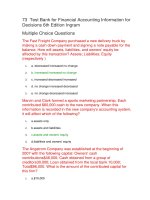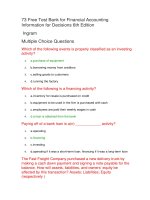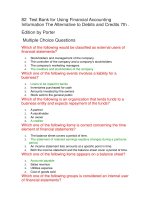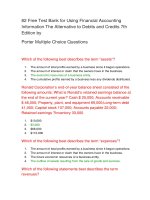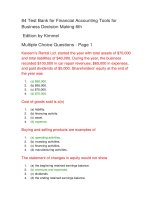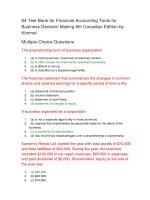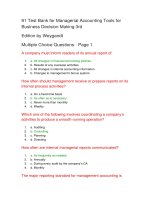174 test bank for financial accounting tools for business decision making 7th edition
Bạn đang xem bản rút gọn của tài liệu. Xem và tải ngay bản đầy đủ của tài liệu tại đây (190.42 KB, 38 trang )
174 Test Bank for Financial Accounting Tools for Business
Decision Making 7th Edition
True - False Questions
Assets are resources owned by a business and provide future
services or benefits to the business.
1.
True
2.
False
Owners of business firms are the only people who need
accounting information.
1.
True
2.
False
The management discussion and analysis (MD & A) section of an
annual report covers various financial aspects of a
company.
1.
True
2.
False
The balance sheet reports assets and claims to those assets at a
specific point in time.
1.
True
2.
False
The purchase of equipment is an example of a financing activity.
1.
True
2.
False
Accounting communicates financial information about a
business to both internal and external users.
1.
True
2.
False
Claims of creditors and owners on the assets of a business are
called liabilities.
1.
True
2.
False
Examples of notes are descriptions of the significant accounting
policies and methods used in preparing the statements,
explanations of contingencies, and various statistics.
1.
True
2.
False
The primary purpose of the statement of cash flows is to provide
information about the cash receipts and cash payments of
a company for a specific period of time.
1.
True
2.
False
A different set of financial statements usually is prepared for
each user.
1.
True
2.
False
Two primary external users of accounting information are
investors and creditors.
1.
True
2.
False
Management of a business enterprise is the major external user
of information.
1.
True
2.
False
Financing activities for corporations include borrowing money
and selling shares of their own stock.
1.
True
2.
False
The majority of U.S. business is transacted by proprietorships.
1.
True
2.
False
The liability of corporate stockholders is limited to the amount of
their investment.
1.
True
2.
False
The information needs and questions of external users vary
considerably.
1.
True
2.
False
All publicly traded U.S. companies must provide their
stockholders with an annual report each year.
1.
True
2.
False
One way of stating the accounting equation is: Assets +
Liabilities = Stockholders’ Equity.
1.
True
2.
False
If the assets owned by a business total $150,000 and liabilities
total $105,000, stockholders’ equity totals $45,000.
1.
True
2.
False
The basic accounting equation states that Assets = Liabilities.
1.
True
2.
False
An auditor is an accounting professional who conducts an
independent examination of the accounting data presented
by a company.
1.
True
2.
False
Creditors’ rights to assets supersede owners’ rights to the
assets.
1.
True
2.
False
The accounting equation can be expressed as Assets - Liabilities
= Stockholders’ Equity.
1.
True
2.
False
Information in the notes to the financial statements has to be
quantifiable (numeric).
1.
True
2.
False
Net income is another term for revenue.
1.
True
2.
False
Operating activities involve putting the resources of the
business into action to generate a profit.
1.
True
2.
False
Proprietorships in the United States generate more revenue than
the other two forms of business enterprise.
1.
True
2.
False
Net income for the period is determined by subtracting total
expenses and dividends from revenues.
1.
True
2.
False
A business is usually involved in two types of activity—financing
and investing.
1.
True
2.
False
Explanatory notes and supporting schedules are an optional part
of an annual report.
1.
True
2.
False
External users of accounting information are managers who
plan, organize, and run a business.
1.
True
2.
False
If the assets owned by a business total $100,000 and liabilities
total $65,000, stockholders’ equity totals $25,000.
1.
True
2.
False
The heading for the income statement might include the line “As
of December 31, 20xx.”
1.
True
2.
False
A business organized as a separate legal entity owned by
stockholders is a partnership.
1.
True
2.
False
Payments to owners are operating activities.
1.
True
2.
False
The economic resources that are owned by a business are called
stockholders’ equity.
1.
True
2.
False
The accounting equation can be expressed as Assets Stockholders’ Equity = Liabilities.
1.
True
2.
False
Cash is another term for stockholders’ equity.
1.
True
2.
False
Investing activities involve collecting the necessary funds to
support the business.
1.
True
2.
False
Corporate stockholders generally pay higher taxes but have no
personal liability.
1.
True
2.
False
Multiple Choice Questions - Page 1
Which of the following groups uses accounting information
primarily to insure the entity is operating within prescribed
rules?
1.
a.Taxing authorities
2.
b.Regulatory agencies
3.
c.Labor Unions
4.
d.Management
Which of the following groups uses accounting information to
determine whether the company’s net income will result in
a stock price increase?
1.
a.Investors in common stock
2.
b.Marketing managers
3.
c.Creditors
4.
d.Chief Financial Officer
Which of the following is the best definition of an internal user of
accounting information?
1.
a.Investors who use accounting information to decide whether to buy or sell stock.
2.
b.Creditors like banks that use accounting information to evaluate the risk of lending
money.
3.
c.Labor unions who use accounting information to examine the ability of the company to
pay increased wages and benefits.
4.
d.Managers who use accounting information to plan, organize, and run a business.
Which of the following is not an advantage of the corporate form
of business organization?
1.
a.No personal liability
2.
b.Easy to transfer ownership
3.
c.Favorable tax treatment
4.
d.Easy to raise funds
Which type of corporate information is not available to
investors?
1.
a.Dividend history
2.
b.Forecast of cash needs for the upcoming year
3.
c.Cash provided by investing activities
4.
d.Beginning cash balance
Which of the following is an advantage of corporations relative to
partnerships and sole proprietorships?
1.
a.Reduced legal liability for investors
2.
b.Harder to transfer ownership
3.
c.Lower taxes
4.
d.Most common form of organization
Which of the following would not be considered an external user
of accounting data for the Julian Company?
1.
a.Internal Revenue Service agent
2.
b.Management
3.
c.Creditors
4.
d.Customers
The proprietorship form of business organization
1.
a.must have at least two owners in most states.
2.
b.generally receives favorable tax treatment relative to a corporation.
3.
c.combines the records of the business with the personal records of the owner.
4.
d.is classified as a separate legal entity.
Which of the following is the most appropriate and modern
definition of accounting?
1.
a.The information system that identifies, records, and communicates the economic
events of an organization to interested users.
2.
b.A means of collecting information.
3.
c.The interconnected network of subsystems necessary to operate a business.
4.
d.Electronic collection, organization, and communication of vast amounts of information.
A business organized as a corporation
1.
a.is not a separate legal entity in most states.
2.
b.requires that stockholders be personally liable for the debts of the business.
3.
c.is owned by its stockholders.
4.
d.has tax advantages over a proprietorship or partnership.
Jack and Jill form a partnership. Jack runs the business in New
York, while Jill vacations in Hawaii. During the time Jill is
away from the business, Jack increases the debts of the
business by $20,000. Which of the following statements is
true regarding this debt?
1.
a.Only Jack is personally liable for the debt, since he has been the managing partner
during that time.
2.
b.Only Jill is personally liable for the debt of the business, since Jack has been working
and she has not.
3.
c.Both Jack and Jill are personally liable for the business debt.
4.
d.Neither Jack nor Jill is personally liable for the business debt, since the partnership is a
separate legal entity.
Which of the following statements is not true regarding the
Sarbanes-Oxley Act (SOX)?
1.
a.The Act calls for increased oversight responsibilities for boards of directors.
2.
b.The Act has resulted in increased penalties for financial fraud by top management.
3.
c.The Act calls for decreased independence of outside auditors reviewing corporate
financial statements.
4.
d.The Act is meant to decrease the likelihood of unethical corporate behavior.
Which of the following groups uses accounting information to
determine whether a marketing proposal will be cost
effective?
1.
a.Investors in common stock
2.
b.Marketing managers
3.
c.Creditors
4.
d.Chief Financial Officer
The liability created by a business when it purchases coffee
beans and coffee cups on credit from suppliers is termed
a(n)
1.
a.account payable.
2.
b.account receivable.
3.
c.revenue.
4.
d.expense.
Which of the following is not one of the three forms of business
organization?
1.
a.Corporations
2.
b.Partnerships
3.
c.Proprietorships
4.
d.Investors
A corporation has which of the following set of characteristics?
1.
a.Shared control, tax advantages, increased skills and resources
2.
b.Simple to set up and maintains control with founder
3.
c.Easier to transfer ownership and raise funds, no personal liability
4.
d.Harder to raise funds and gives owner control
External users of accounting information, like the Internal
Revenue Service, are most commonly known as
1.
a.taxing authorities.
2.
b.labor unions.
3.
c.customers.
4.
d.regulatory agencies.
Which one of the following questions is most likely asked by an
internal human resources director for the company?
1.
a.Which product line is most profitable?
2.
b.What price for our product will maximize the company income?
3.
c.What average pay raise is affordable for employees this year?
4.
d.Should any product lines be eliminated?
Which of the following would not be considered an internal user
of accounting data for the Xanadu Company?
1.
a.President of the company
2.
b.Production manager
3.
c.Merchandise inventory clerk
4.
d.President of the employees' labor union
A business organized as a separate legal entity is a
1.
a.corporation.
2.
b.proprietor.
3.
c.government unit.
4.
d.partnership.
The partnership form of business organization
1.
a.is a separate legal entity.
2.
b.is a common form of organization for service-type businesses.
3.
c.enjoys an unlimited life.
4.
d.has limited liability.
The group of users of accounting information charged with
achieving the goals of the business is its
1.
a.auditors.
2.
b.investors.
3.
c.managers.
4.
d.creditors.
A local retail shop has been operating as a sole proprietorship.
The business is growing and now the owner wants to
incorporate. Which of the following is not a reason for this
owner to incorporate?
1.
a.Ability to raise capital for expansion
2.
b.Desire to limit the owner’s personal liability
3.
c.The prestige of operating as a corporation
4.
d.The ease in transferring shares of the corporation’s stock
An advantage of the corporate form of business is that
1.
a.it has limited life.
2.
b.its owner’s personal resources are at stake.
3.
c.its ownership is easily transferable via the sale of shares of stock.
4.
d.it is simple to establish.
Which of the following is a primary user of accounting
information with a direct financial interest in the business?
1.
a.Taxing authority
2.
b.Creditor
3.
c.Regulatory agency
4.
d.Labor union
External users want answers to all of the following questions
except
1.
a.Is the company earning satisfactory income?
2.
b.Will the company be able to pay its debts as they come due?
3.
c.Will the company be able to afford employee pay raises this year?
4.
d.How does the company compare in profitability with competitors?
Which type of corporate information is readily available to
investors?
1.
a.Financial comparison of operating alternatives
2.
b.Marketing strategies for a product that will be introduced in eighteen months
3.
c.Forecasts of cash needs for the upcoming year
4.
d.Amount of net income retained in the business
A small neighborhood barber shop that is operated by its owner
would likely be organized as a
1.
a.joint venture.
2.
b.partnership.
3.
c.corporation.
4.
d.proprietorship.
Which of the following statements concerning users of
accounting information is incorrect?
1.
a.Management is considered an internal user.
2.
b.Present creditors are considered external users.
3.
c.Regulatory authorities are considered internal users.
4.
d.Taxing authorities are considered external users.
Which of the following is not a step for solving an ethical
dilemma?
1.
a.Identifying the alternatives and weighing the impact of each alternative on various
stakeholders.
2.
b.Certifying the ethical accuracy of the financial information.
3.
c.Identifying and analyzing the principal elements in the situation.
4.
d.Recognizing the ethical situation and issues involved.
Which of the following would not be considered an internal user
of accounting data for a company?
1.
a.The president of a company
2.
b.The controller of a company
3.
c.Creditor of a company
4.
d.Salesperson of a company
All of the following are advantages for choosing a proprietorship
for a business except
1.
a.a proprietorship is a simple form of business to set up.
2.
b.a proprietorship gives the owner control of the business.
3.
c.proprietorship receive more favorable tax treatment.
4.
d.transfer of ownership is easily achieved through stock sales.
Which of the following are internal reports that accounting
provides to internal users?
1.
a.Forecasts of cash needs for next year.
2.
b.Financial comparisons of operating activity alternatives.
3.
c.Both forecasts of cash needs and financial comparisons are internal reports.
4.
d.Neither forecasts of cash needs or financial comparisons is an internal report.
Most business enterprises in the United States are
1.
a.proprietorships and partnerships.
2.
b.partnerships.
3.
c.corporations.
4.
d.government units.
Which of the following is a user of accounting information with
an indirect financial interest in a business?
1.
a.A financial adviser
2.
b.Management
3.
c.Investor
4.
d.Creditor
Which of the following groups uses accounting information to
determine whether the company can pay its obligations?
1.
a.Investors in common stock
2.
b.Marketing managers
3.
c.Creditors
4.
d.Chief Financial Officer
134 Free Test Bank for Financial Accounting Tools for
Business Decision Making 7th Edition by Kimmel
Multiple Choice Questions - Page 2
Debts and obligations of a business are referred to as
1.
a.assets.
2.
b.equities.
3.
c.liabilities.
4.
d.expenses.
The retained earnings statement shows all of the following
except
1.
a.the amounts of changes in retained earnings during the period.
2.
b.the causes of changes in retained earnings during the period.
3.
c.the time period following the one shown for the income statement.
4.
d.beginning retained earnings on the first line of the statement.
Borrowing money is an example of a(n)
1.
a.delivering activity.
2.
b.financing activity.
3.
c.investing activity.
4.
d.operating activity.
Jackson Company recorded the following cash transactions for
the year: Paid $135,000 for salaries; Paid $60,000 to
purchase office equipment; Paid $15,000 for utilities; Paid
$6,000 in dividends; Collected $245,000 from customers;
What was Jackson’s net cash provided by operating
activities?
1.
a.$95,000
2.
b.$35,000
3.
c.$110,000
4.
d.$89,000
Dividends paid
1.
a.increase assets.
2.
b.increase expenses.
3.
c.decrease revenues.
4.
d.decrease retained earnings.
Which of the following is an asset?
1.
a.Mortgage payable
2.
b.Investments
3.
c.Common stock
4.
d.Retained earnings
The right to receive money in the future is called a(n)
1.
a.account payable.
2.
b.account receivable.
3.
c.liability.
4.
d.revenue.
Which of the following financial statements is divided into major
categories of operating, investing, and financing
activities?
1.
a.The income statement.
2.
b.The balance sheet.
3.
c.The retained earnings statement.
4.
d.The statement of cash flows.
Which activities involve putting the resources of the business
into action to generate a profit?
1.
a.Delivering
2.
b.Financing
3.
c.Investing
4.
d.Operating
Buying assets needed to operate a business is an example of
a(n)
1.
a.delivering activity.
2.
b.financing activity.
3.
c.investing activity.
4.
d.operating activity.
The best definition of assets is the
1.
a.cash owned by the company.
2.
b.collections of resources belonging to the company and the claims on these resources.
3.
c.owners’ investment in the business.
4.
d.resources belonging to a company that have future benefit to the company.
When expenses exceed revenues, which of the following is true?
1.
a.a net loss results
2.
b.a net income results
3.
c.assets equal liabilities
4.
d.assets are increased
Issuing shares of stock in exchange for cash is an example of
a(n)
1.
a.delivering activity.
2.
b.investing activity.
3.
c.financing activity.
4.
d.operating activity.
The common characteristic possessed by all assets is
1.
a.long life.
2.
b.great monetary value.
3.
c.tangible nature.
4.
d.future economic benefit.
Debt securities sold to investors that must be repaid at a
particular date some years in the future are called
1.
a.accounts payable.
2.
b.notes receivable.
3.
c.taxes payable.
4.
d.bonds payable.
Gibson Company recorded the following cash transactions for
the year: Paid $180,000 for salaries; Paid $80,000 to
purchase office equipment; Paid $20,000 for utilities; Paid
$8,000 in dividends; Collected $310,000 from customers.
What was Gibson’s net cash provided by operating
activities?
1.
a.$110,000
2.
b.$30,000
3.
c.$130,000
4.
d.$102,000
Resources owned by a business are referred to as
1.
a.stockholders’ equity.
2.
b.liabilities.
3.
c.assets.
4.
d.revenues.
Ending retained earnings for a period is equal to beginning
1.
a.Retained earnings + Net income + Dividends
2.
b.Retained earnings – Net income – Dividends
3.
c.Retained earnings + Net income – Dividends
4.
d.Retained earnings – Net income + Dividends
Which of the following activities involves collecting the
necessary funds to support the business?
1.
a.Operating
2.
b.Investing
3.
c.Financing
4.
d.Delivering
Dividends are reported on the
1.
a.income statement.
2.
b.retained earnings statement.
3.
c.balance sheet.
4.
d.income statement and balance sheet.
Which of the following statements is true?
1.
a.Amounts received from issuing stock are revenues.
2.
b.Amounts paid out as dividends are not expenses.
3.
c.Amounts paid out as dividends are reported on the income statement.
4.
d.Amounts received from issued stock are reported on the income statement.
Which of the following is not a principal type of business
activity?
1.
a.Operating
2.
b.Investing
3.
c.Financing
4.
d.Delivering
Which of the following is not a liability?
1.
a.Unearned Service Revenue
2.
b.Accounts Payable
3.
c.Accounts Receivable
4.
d.Interest Payable
The cost of assets consumed or services used is also known as
1.
a.a revenue.
2.
b.an expense.
3.
c.a liability.
4.
d.an asset.
Which activities involve acquiring the resources to run the
business?
1.
a.Delivering
2.
b.Financing
3.
c.Investing
4.
d.Operating
Expenses are incurred
1.
a.only on rare occasions.
2.
b.to produce assets.
3.
c.to produce liabilities.
4.
d.to generate revenues.
Buying and selling products are examples of
1.
a.operating activities.
2.
b.investing activities.
3.
c.financing activities.
4.
d.delivering activities.
The financial statement that summarizes the changes in retained
earnings for a specific period of time is the
1.
a.balance sheet.
2.
b.income statement.
3.
c.statement of cash flows.
4.
d.retained earnings statement.
The statement of cash flows would disclose the payment of a
dividend
1.
a.nowhere on the statement.
2.
b.in the operating activities section.
3.
c.in the investing activities section.
4.
d.in the financing activities section.
134 Free Test Bank for Financial Accounting Tools for
Business Decision Making 7th Edition by Kimmel
Multiple Choice Questions - Page 3
Jimmy’s Repair Shop started the year with total assets of
$200,000 and total liabilities of $160,000. During the year
the business recorded $420,000 in revenues, $220,000 in
expenses, and dividends of $40,000. The net income
reported by Jimmy’s Repair Shop for the year was
1.
a.$160,000.
2.
b.$200,000.
3.
c.$120,000.
4.
d.$380,000.
The retained earnings statement
1.
a.summarizes the changes in retained earnings for a specific period of time.
2.
b.reports the changes in assets, liabilities, and stockholders’ equity over a period of time.
3.
c.reports the assets, liabilities, and stockholders’ equity at a specific date.
4.
d.presents the revenues and expenses for a specific period of time.
Which of the following is not a satisfactory statement of the
accounting equation?
1.
a.Assets = Stockholders’ Equity – Liabilities
2.
b.Assets = Liabilities + Stockholders’ Equity
3.
c.Assets - Liabilities = Stockholders’ Equity
4.
d.Assets - Stockholders’ Equity = Liabilities
If the retained earnings account increases from the beginning of
the year to the end of the year, then
1.
a.net income is less than dividends.
2.
b.a net loss is less than dividends.
3.
c.additional investments are less than net losses.
4.
d.net income is greater than dividends.
Net income will result during a time period when
1.
a.assets exceed liabilities.
2.
b.assets exceed revenues.
3.
c.expenses exceed revenues.
4.
d.revenues exceed expenses.
The balance sheet
1.
a.summarizes the changes in retained earnings for a specific period of time.
2.
b.reports the changes in assets, liabilities, and stockholders’ equity over a period of time.
3.
c.reports the assets, liabilities, and stockholders’ equity at a specific date.
4.
d.presents the revenues and expenses for a specific period of time.
If the retained earnings account decreases from the beginning of
the year to the end of the year, then
1.
a.net income is less than dividends.
2.
b.there was a net income and no dividends.
3.
c.additional investments are less than net losses.
4.
d.net income is greater than dividends.
If total liabilities increased by $75,000 and stockholders’ equity
increased by $25,000 during a period of time, then total
assets must change by what amount and direction during
that same period?
1.
a.$100,000 decrease
2.
b.$100,000 increase
3.
c.$125,000 increase
4.
d.$150,000 increase
If total liabilities increased by $46,000 during a period of time and
stockholders’ equity decreased by $18,000 during the
same period, then the amount and direction (increase or
decrease) of the period’s change in total assets is a(n)
1.
a.$46,000 increase.
2.
b.$64,000 increase.
3.
c.$28,000 decrease.
4.
d.$28,000 increase.
Finney Company began the year by issuing $40,000 of common
stock for cash. The company recorded revenues of
$370,000, expenses of $320,000, and paid dividends of
$20,000. What was Finney’s net income for the year?
1.
a.$30,000
2.
b.$70,000
3.
c.$50,000
4.
d.$90,000
Which of the following financial statements is concerned with the
company at a point in time?
1.
a.Balance sheet
2.
b.Income statement
3.
c.Retained earnings statement
4.
d.Statement of cash flows
Henson Company began the year with retained earnings of
$330,000. During the year, the company recorded revenues
of $500,000, expenses of $380,000, and paid dividends of
$40,000. What was Henson’s retained earnings at the end
of the year?
1.
a.$490,000
2.
b.$410,000
3.
c.$790,000
4.
d.$450,000
Retained earnings at the end of the period is equal to
1.
a.retained earnings at the beginning of the period plus net income minus liabilities.
2.
b.retained earnings at the beginning of the period plus net income minus dividends.
3.
c.net income.
4.
d.assets plus liabilities.
Kilmer Corporation began the year with retained earnings of
$620,000. During the year, the company issued $840,000 of
common stock, recorded expenses of $2,400,000, and paid
dividends of $160,000. If Kilmer’s ending retained earnings
was $660,000, what was the company’s revenue for the
year?
1.
a.$2,440,000
2.
b.$2,600,000
3.
c.$3,280,000
4.
d.$33,440,000
Gilkey Corporation began the year with retained earnings of
$465,000. During the year, the company issued $630,000 of
common stock, recorded expenses of $1,800,000, and paid
dividends of $120,000. If Gilkey’s ending retained earnings
was $495,000, what was the company’s revenue for the
year?
1.
a.$1,830,000
2.
b.$1,950,000
3.
c.$2,460,000
4.
d.$2,580,000
If total liabilities decreased by $75,000 and stockholders’ equity
decreased by $25,000 during a period of time, then total
assets must change by what amount and direction during
that same period?
1.
a.$100,000 increase
2.
b.$50,000 decrease
3.
c.$100,000 decrease
4.
d.$50,000 decrease
To show how successfully your business performed during a
period of time, you would report its revenues and
expenses in the
1.
a.balance sheet.
2.
b.income statement.
3.
c.statement of cash flows.
4.
d.retained earnings statement.
Which financial statement is prepared first?
1.
a.Balance sheet
2.
b.Income statement
3.
c.Retained earnings statement
4.
d.Statement of cash flows
Net income results when
1.
a.Assets > Liabilities.
2.
b.Revenues = Expenses.
3.
c.Revenues > Expenses.
4.
d.Revenues < Expenses.
The retained earnings statement would not show
1.
a.the retained earnings beginning balance.
2.
b.revenues and expenses.
3.
c.dividends.
4.
d.the ending retained earning balance.
The company’s policy toward dividends and growth could best
be determined by examining the
1.
a.balance sheet.
2.
b.income statement.
3.
c.retained earnings statement.
4.
d.statement of cash flows.
